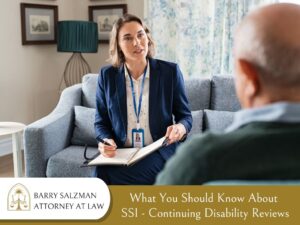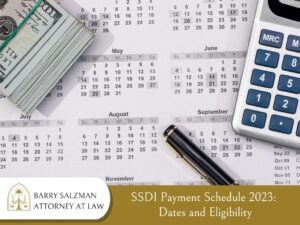Veteran Disability Compensation: What You Need to Know
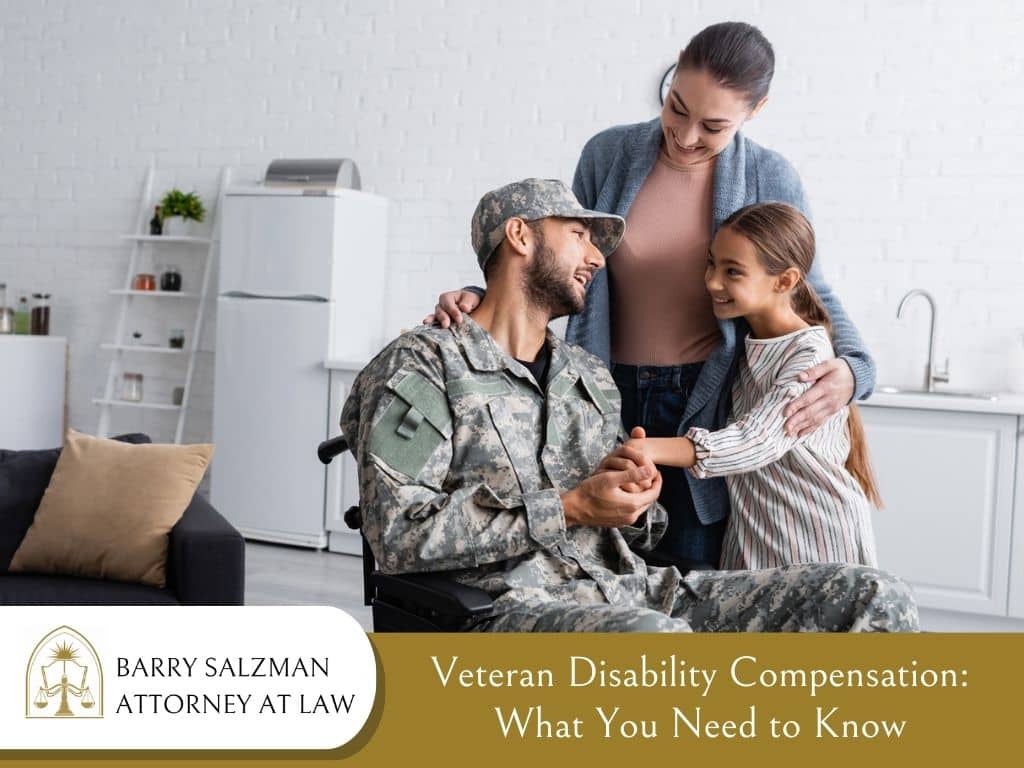
The VA administers a broad scope of benefits available to veterans, including disability benefits, health care, benefits for family members and survivors, pension benefits, burial and memorial benefits, education benefits, vocational/retraining benefits, home loan guaranty, and life insurance.
This article will deal only with disability compensation benefits. The VA administers two categories of disability benefits: disability compensation and disability pension.
What is Veteran Disability Compensation?
Disability compensation is available to veterans who have been discharged from service under other than dishonorable conditions (usually, this means an honorable discharge or general discharge under honorable conditions).
Who Is Eligible to Receive Veteran Disability Compensation?
To become entitled to disability compensation, a veteran must first establish that he/she has a “current disability”. This means that you have a physical or mental condition that is presently causing some limitations of abilities. The disability you are claiming must be disabling at the time you are making your claim.
Compensation is available if the veteran has a current disabling condition caused by something that occurred while in service. This is called “service connection”.
Disability pension, on the other hand, is available to veterans who do not have a service-connected disability but who are permanently and totally disabled and have very limited financial resources. Disability pension is only available to veterans with wartime service.
What Does Service Connection Mean?
Service connection means that something happened while in service that caused the current disability. This means that you must have evidence that establishes that some disease, injury, or event occurred while in service that caused or brought about a current disability.
Establishing Service Connection for Disability Benefits
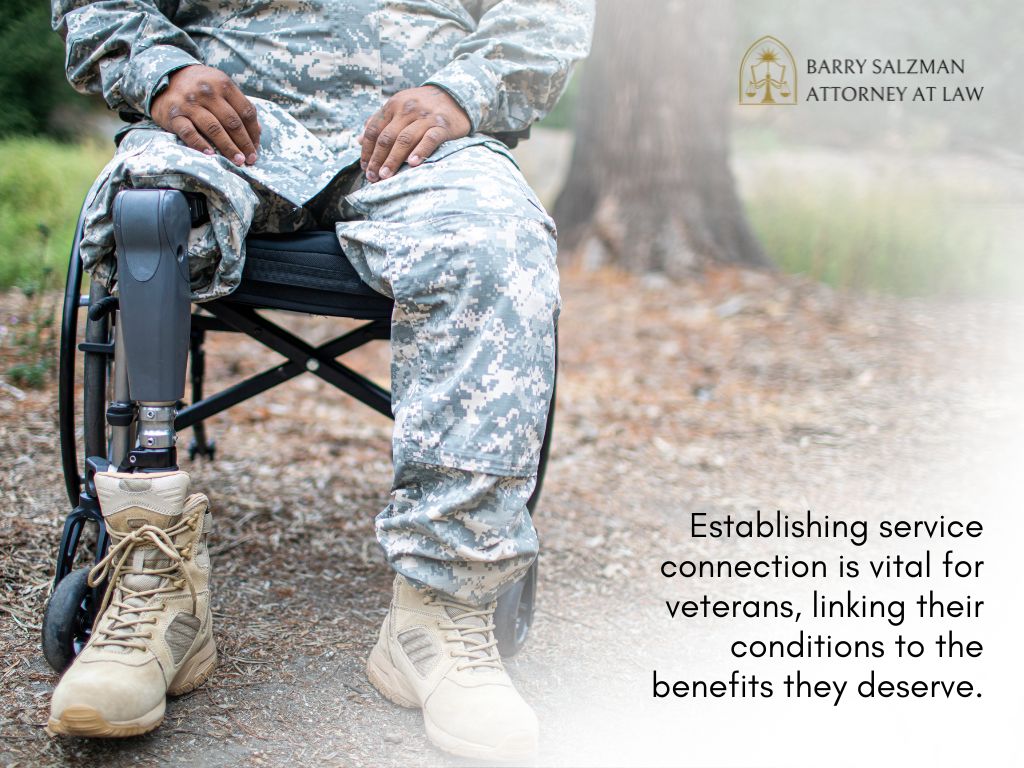
Service connection does not necessarily mean that the performance of service-related duties caused some injury or disease. It is only necessary to establish that the condition arose or first became manifest while in service. For example, if you did not have diabetes when you entered service but were diagnosed with diabetes while in service, the diabetes is service-connected.
Conditions that you had prior to entry into service cannot be service-connected unless that condition was aggravated while in service. Proof of service connection cannot be established solely based on your own report or testimony. You must be able to offer corroborating evidence of what occurred while in service. This usually means that there is some evidence in your military records that your injury or disease was treated while in service.
Nexus and Its Role in Service Connection
There must also be evidence that there is a “nexus” or connection between what occurred while in service and your current disability. For example, a simple ankle sprain during boot camp that healed without complication cannot be connected to a foot condition that occurs 20 years after discharge.
Secondary Service Connection and Its Criteria
Service connection may also be established on a secondary basis. Diabetes is known to cause heart disease. If you have a service-connected rating for diabetes and years later develop heart disease, the heart disease may be service-connected even though heart disease was not diagnosed while in service. In short, any non-service-connected condition that was caused or aggravated by a service-connected condition will be service-connected on a secondary basis.
Presumptive Service Connection for Certain Conditions
Some conditions may be service-connected on a presumptive basis. The most familiar condition in this category is Agent Orange exposure. Agent Orange is known to cause a long list of cancers and other conditions, including heart disease and diabetes. Studies conducted by the VA demonstrated that soldiers and sailors who served in Vietnam were far more likely to develop such diseases than those found in the general population. Because it is nearly impossible to determine how much exposure each veteran may have had in Vietnam, the VA created a presumption that any service in Vietnam is sufficient to service-connect any of the conditions on the list of Agent Orange-associated diseases.
Similar presumptions are available for certain tropical diseases, conditions due to radiation or other contaminant exposure, certain chronic diseases diagnosed within a year after discharge, diseases associated with the Gulf wars, amyotrophic lateral sclerosis, and for prisoners-of-war. The VA also presumes that participation in direct combat with the enemy is a sufficient basis to service-connect PTSD.
Service Connection for Injuries or Diseases Caused by VA Activities
Service connection may also be provided for injuries or diseases caused by VA health care or other VA activities such as vocational rehabilitation.
Understanding the VA’s Disability Rating System
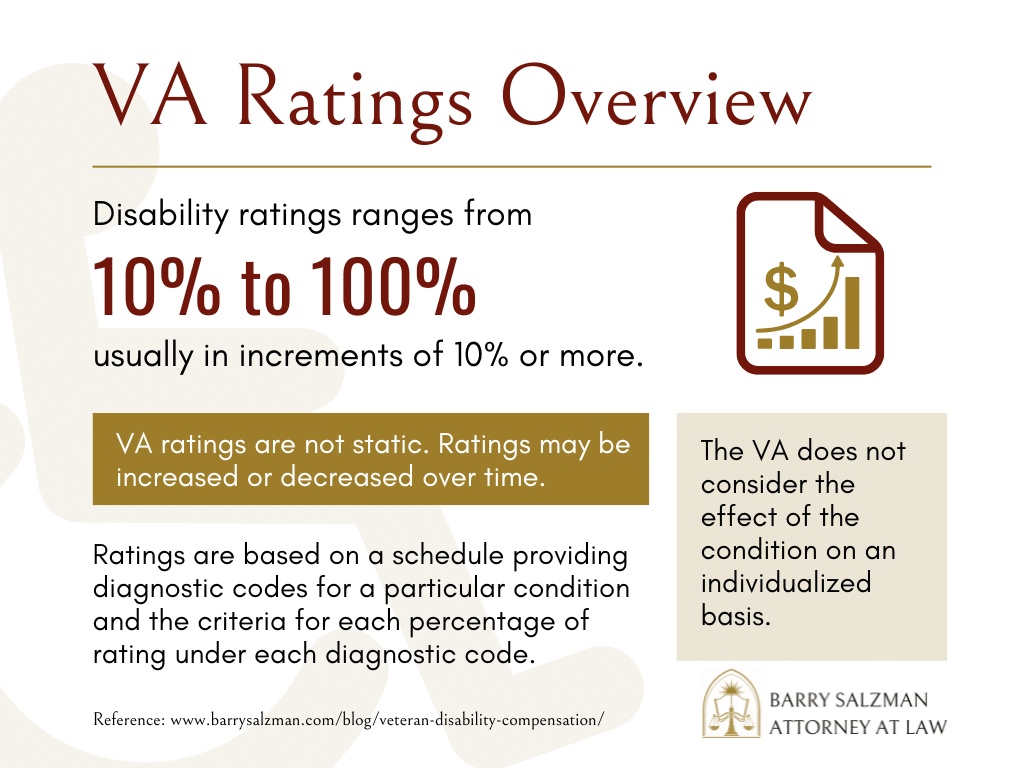
The VA must provide a rating when a veteran establishes that he/she has a service-connected condition. The rating is expressed as a percentage, usually in increments of 10% or more. The compensation paid to the veteran is based on the percentage rating; for example, a 10% rating (regardless of the condition) results in a monthly payment of $165.92. A 100% rating results in a monthly payment of $3,621.95 for a veteran without a spouse or children (higher amounts with a spouse and/or children).
VA ratings are intended to reflect the relative effect of the rated condition on the veteran’s ability to work. The VA does not consider the effect of the condition on an individualized basis. For example, ringing in the ears (known as tinnitus) produces a 10% rating for any veteran with this condition. It does not matter that tinnitus may affect one veteran more than another.
Ratings are based on a schedule providing diagnostic codes for a particular condition and the criteria for each percentage of rating under each diagnostic code. This schedule embraces physical as well as mental conditions. For example, diabetes (Diagnostic Code 7913) that can be managed by diet alone without medication results in a 10% rating, while diabetes that requires one or more injections of insulin, restricted diet, and regulation of activities results in a 40% rating.
Conditions that are service-connected but produce symptoms may result in a 0% rating which results in no benefit payment. VA ratings are not static. Ratings may be increased or decreased over time. For example, if diabetes, currently rated at 10%, worsens over the years requiring insulin injections, the veteran may file a claim for an increased rating.
Effective Date
The effective date of an award of compensation is generally the date the claim was made. “Effective date” means the date from which compensation is paid. This means that if you make a successful claim for knee pain due to injury in service that has been bothering you for years before the claim was filed, compensation payments cannot begin any earlier than the date the claim was filed. There are exceptions to this rule that are beyond the scope of this article. Likewise, the effective date of a claim for an increased rating is the date the claim for an increased rating is made, not the date of the original claim.
Claiming Compensation
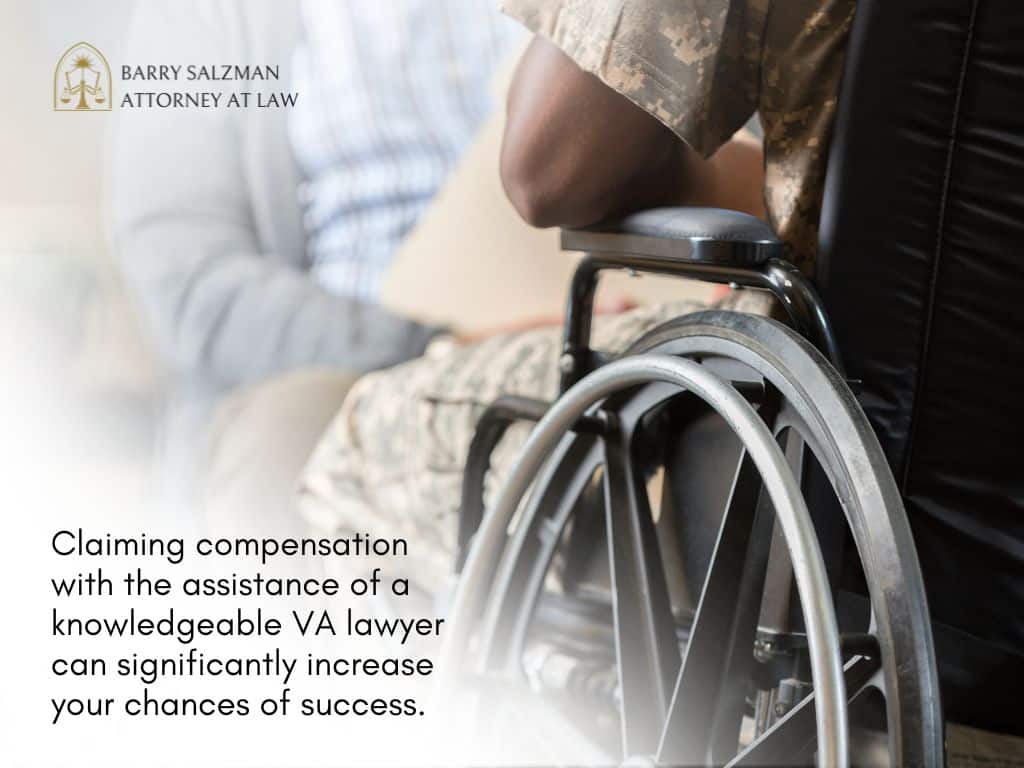
An initial claim for compensation is a claim for a condition that has never been made previously. Compensation claims must be filed on specific VA forms. Failure to do so may delay the processing of the claim.
Types of Compensation Claims
A claim for an increased rating is a new claim and must proceed as an initial claim. A claim may be made for conditions previously claimed but denied if new and material evidence is available that may result in a favorable decision, even if the appeal period for the previously denied claim has expired. These are referred to as supplemental claims. Initial and supplemental claims are processed by the VA’s regional offices (RO) throughout the country.
Duties of the VA’s Regional Offices (RO) In Processing Claims
With an initial claim, the RO must acquire your military records (personnel and treatment records), acquire all relevant medical records, and provide for specialized medical examinations to assess your disability. The VA has a duty to assist you in obtaining the evidence necessary to establish your claim by notifying you of what evidence is needed and assisting you in obtaining that evidence.
Once the investigation of your claim is complete, the RO issues a rating decision, either granting benefits with a percentage rating or denying the claim. The rating decision must explain the basis on which the claim was granted or denied. Although the VA has streamlined the initial claims process somewhat, the process can take several months to complete.
Appealing a Denial of Benefits
If your claim is denied, you have one year within which to appeal the decision. There are multiple avenues of appeal. If you believe a mistake was made in the decision that does not require the consideration of additional evidence, you may request a “higher level review” in which your case will be sent to a senior rating officer to review the decision for errors.
For example, the rating officer who denied the claim may have failed to consider evidence, may have applied a VA regulation improperly, or may have applied an incorrect rating schedule.
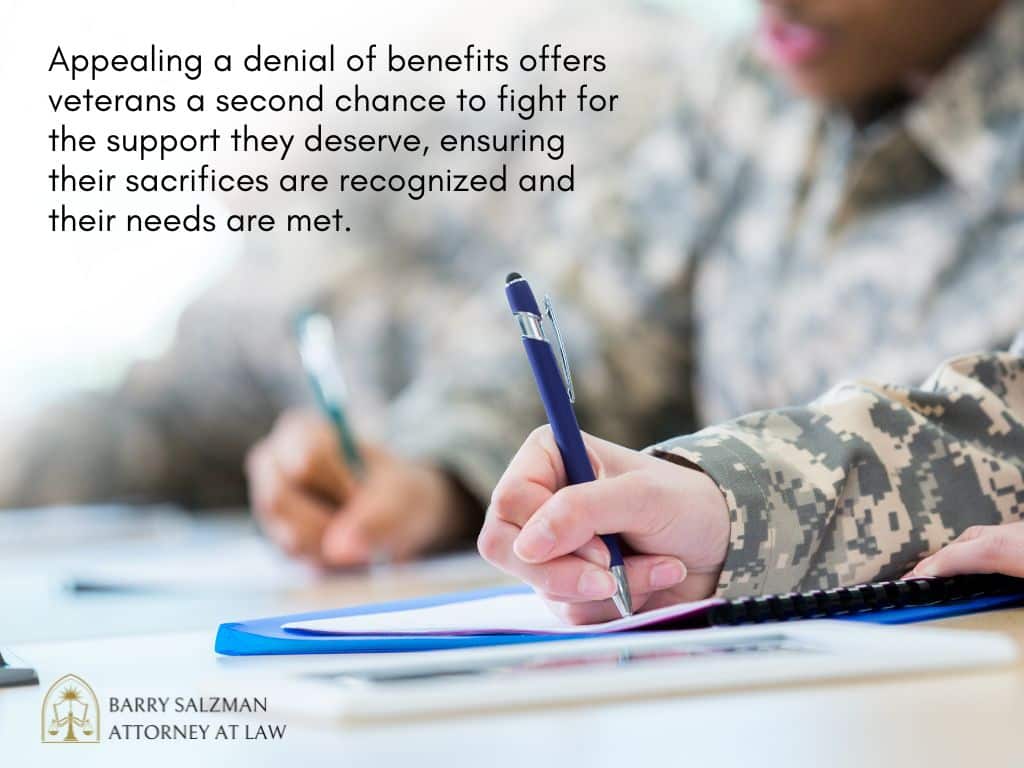
Supplemental Claims With New and Material Evidence
If you have additional evidence that was not considered when the claim was denied, you may present that evidence in a supplemental claim. If the new evidence results in a favorable decision, the effective date for the decision will be the date of the original claim, provided the supplemental claim was filed within one year of the denial.
A supplemental claim may be filed for a previously denied claim that was not appealed within one year if new and material evidence results in a favorable decision; however, the effective date, in that case, will be the date the supplemental claim was filed. As with original claims, supplemental claims are adjudicated by the RO. If the request for higher-level review or a supplemental claim is denied, the veteran may appeal that decision to the Board of Veterans Appeals (BVA) through a Notice of Disagreement.
BVA Hearings and Consideration of Additional Evidence
The BVA is the final level of appeal within the VA. The Board allows the claimant an opportunity for a hearing for the veteran and others to provide testimony and additional evidence in support of the claim. The Board allows for consideration of the appeal without a hearing, with a hearing at the local RO (known as a travel board hearing), a hearing by video teleconference, or a hearing at the Board’s office in Washington, DC.
The Board may take several actions on your appeal. It may find that the RO failed to properly consider evidence or VA regulations and send the case back to the RO for further adjudication. If service connection was an issue, the Board may grant service connection but must send the case back to the RO to determine a rating.
The Board may, in some instances, award benefits directly. On appeal to the Board, your case is assigned to a Veterans Law Judge who conducts the hearing and issues a decision. The decision provides a detailed explanation of the judge’s decision.
Appeals in the Federal Courts
If the Board denies your claim, you may file an appeal with the Court of Appeals for Veterans’ Claims (CAVC). CAVC is a specialized federal court with the same status as a federal district court insofar as the review of final adjudication decisions of a federal agency.
The CAVC is a true appellate court. It does not have the authority to consider any additional evidence. It may only consider what evidence was before the Board when it made its decision. The CAVC considers the adequacy of the evidence that supports the Board’s decision and whether that decision was consistent with VA law and regulations.
Appeal to the CAVC must be made within 120 days of the Board’s decision. An adverse decision by the CAVC may be appealed to the Circuit Court of Appeals for the Federal Circuit in Washington, DC. This court will not review issues concerning the adequacy of evidence; it will only consider legal issues concerning the interpretation of VA law and regulations. In rare instances, the United States Supreme Court may consider a decision from the Federal Circuit.
The adjudication of VA claims can take a very long time, depending on how many appeals must be made. Despite recent reforms in the appeals process, the Board labors under a huge backlog of cases entailing years of waiting for a decision.
Lawyers, Lawyers Fees, and Do I Need a Lawyer?
When navigating the complex process of VA disability claims, many veterans wonder whether they need a lawyer and how lawyer fees work. Understanding the role of lawyers and the fee structure is crucial for making informed decisions.
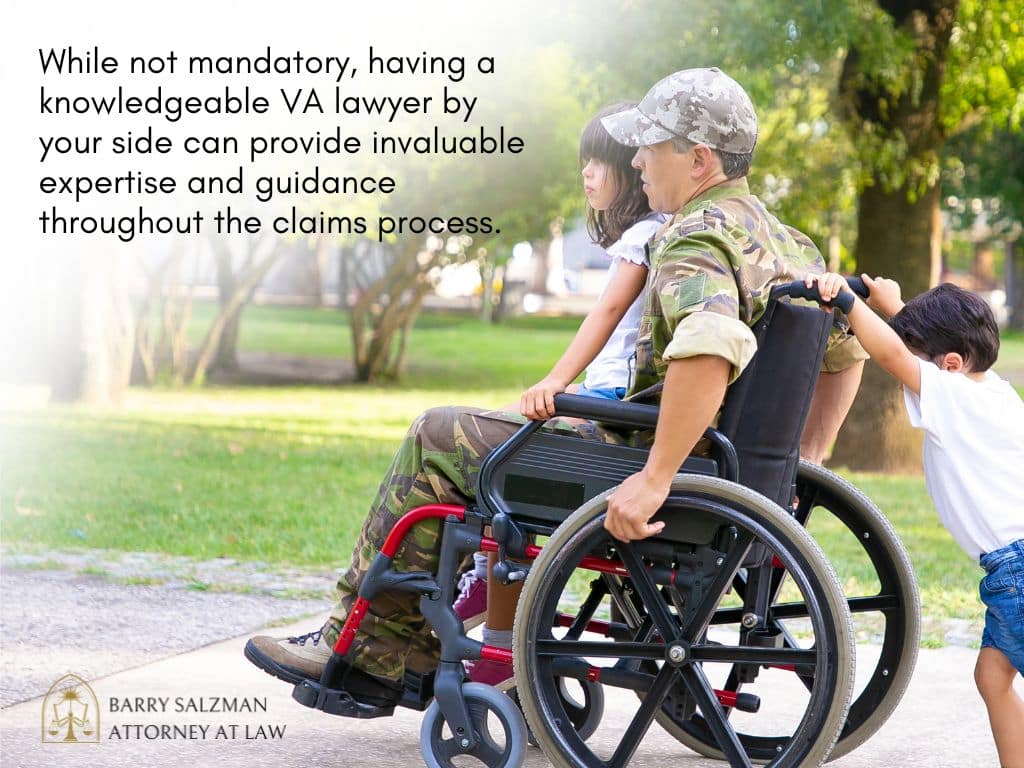
Historical Perspective on Attorney Fees for Veterans’ Claims
When the VA was established in 1862, lawyers could charge no more than $5. In 1864 the fee was increased to $10 and remained at that amount until 1988, when attorneys were not permitted to charge any fee until the Board issued a final decision from which an appeal to the federal courts could be taken.
In 2007 Congress determined that many veterans needed legal assistance earlier in the claims process and allowed for attorneys to collect a fee after the RO made an initial decision from which an appeal could be taken. In 2019 Congress enacted the Appeals Modernization Act, which essentially continues the ability of lawyers to charge fees after the RO has issued an initial decision.
VA Approval of Fee Agreements and Fee Limitations
Under the current law, the VA must approve any fee agreement with a veteran respecting claims for VA benefits. The most common fee agreement is referred to as a “direct pay” agreement in which the fee is contingent upon an award of benefits and is limited to no more than 20% of retroactive benefits only. This fee agreement is presumed to be reasonable. Under a direct pay agreement, the VA will withhold the attorney fee from the veteran’s retroactive benefits and issue payment directly to the attorney.
Fee Agreements and Payment Arrangements
Veterans and their attorneys may use any other form of an agreement approved by the VA; however, fees due under other than direct pay agreements will not be withheld. This means the lawyer must rely upon the veteran to pay the fee out of his/her benefits. Other forms of agreements include non-contingent hourly rates, fixed fee agreements, and contingent fee agreements exceeding 20% (the VA may approve a 33⅓rd% agreement but will not approve a 40% agreement).
Considerations Regarding Attorney Fees and Retroactive Benefits
Due to the length of time some cases may require, very large retroactive benefits may be awarded, producing a large attorney fee. Some veterans may complain that the attorney fee exceeds the value of the actual time and effort of the attorney. However, the attorney received no fee for services over several years and may have received no fee if the appeal was not successful. If this is a problem for some veterans, they need to be prepared to provide a guarantee of payment for a lesser fee; a promise to pay is insufficient. No lawyer wants to sue a client to get paid.
Do You Have to Have a Lawyer to Pursue Your Claim?
No. You may pursue your claim on your own. The VA regional offices have staff to assist with the forms and filing. The VA has online services to facilitate the filing of claims and the presentation of evidence. Several veterans’ service organizations (American Legion, VFW, AmVets, etc.) are available to assist. That said, VA laws and regulations are not easy to digest. The courts have produced a large body of law not easily accessible or understood by the layperson. Experience in handling cases cannot be overstated.
Takeaway
The most significant factor determining the success of your claim is evidence. Yes, I know, the Federal Circuit Court of Appeals in 2018 found that “pain alone” without a supporting medical diagnosis may be sufficient to establish a “disability”. Please don’t bet the farm that you will get a rating by how loud you scream.
Evidence is not always easily available. Many veterans have been hamstrung because their records were destroyed in a fire at the National Personnel Records Center in 1973. Vietnam veterans who now have conditions due to Agent Orange exposure have experienced difficulty establishing their presence in Vietnam because they were sent there; on temporary duty assignments that were not routinely referenced in their personnel records.
There are means of acquiring that information, just not easily. The VA will provide a medical examination to determine if your current condition is related to service. If the examiner renders a report finding that your condition is not related to service, you may have no chance on appeal without submitting evidence of a contrary medical opinion. That can be expensive. If not done properly, it may not be considered. If you have a simple claim for tinnitus because of service in an artillery battery, you may not need an attorney.
If you have unexplained symptoms due to service in the Gulf Wars, you will need assistance. If nothing else, consultation with an experienced VA lawyer will help you understand whether you have a valid claim and whether you will need assistance. Why wait? Assistance is available now. Call Attorney Barry Salzman Today at (727) 321-4993.
Schedule Your Consultation Today
Navigating the bureaucracy of any disability program is complex and frustrating and often ends in denial.
Don't do it alone! Have a dedicated, experienced advocate on your team.
Fill out the form below or give us a call at 727-321-4993.

